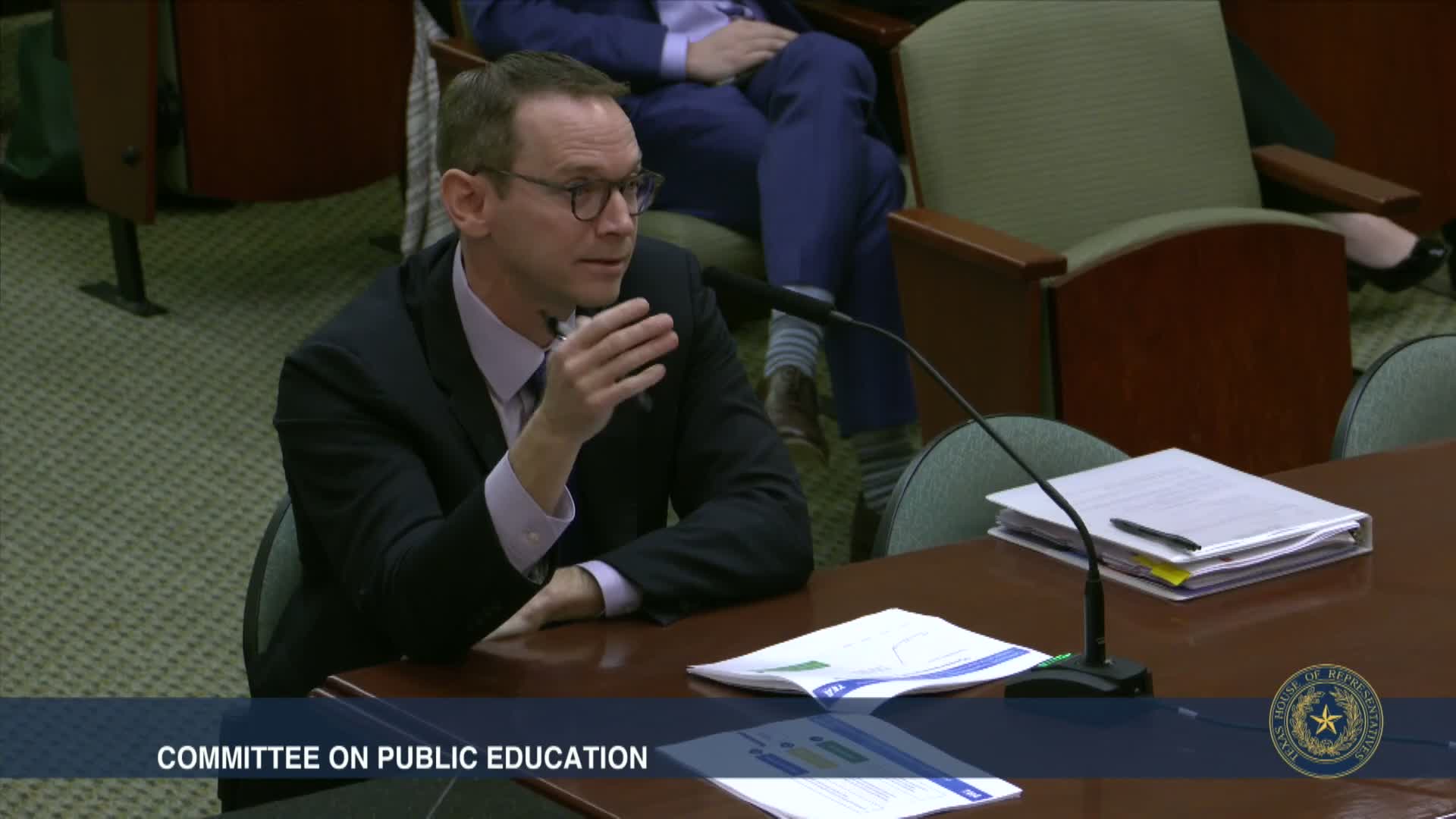Teacher Incentive Allotment grows rapidly but adoption remains uneven, TEA says
February 25, 2025 | Committee on Public Education, HOUSE OF REPRESENTATIVES, Legislative, Texas
This article was created by AI summarizing key points discussed. AI makes mistakes, so for full details and context, please refer to the video of the full meeting. Please report any errors so we can fix them. Report an error »

The Teacher Incentive Allotment — a state program that directs extra funding to districts that run rigorous teacher evaluation and pay systems — has grown significantly since 2019 but remains adopted by a minority of districts, Texas Education Agency staff told the House Committee on Public Education.
Commissioner Mike Morath said the number of designated TIA teachers rose from about 4,000 soon after the law passed to roughly 25,000 statewide in the most recent year, spread across “597 districts that are ... in the pool right now.” He estimated the program covered less than 10% of the state's roughly 380,000 teachers in the current year.
Why it matters
TIA links stronger, calibrated teacher evaluation systems to extra compensation and is intended to raise pay for high‑performing teachers and improve retention. Committee members focused on why adoption has been uneven and what barriers keep districts and teachers from participating.
Details and context
- Administrative and equity hurdles: Morath said a district must show a “fair teacher evaluation system” with reliable, calibrated observations and a valid measure of student growth in order to participate. He and members said smaller central offices find the necessary calibration and technical work to be an administrative burden.
- Participation patterns: Morath said early adopters often launched the program narrowly by grade or subject and then expanded; full adoption in a district can take multiple years. He described the program’s expansion as “a slow but rapid curved increase.”
- Impact where in use: TEA data cited by Morath shows TIA participants have higher retention (about 8% higher) and stronger student growth measures than non‑TIA peers where implemented. He said average TIA designation confers roughly $11,000 in extra pay for designated teachers and that many TIA teachers earn salaries in the $70,000s; some designated teachers are above six figures under local pay structures.
Lawmakers’ concerns and suggestions
Members suggested the legislature consider targeted administrative funding to help districts stand up valid evaluation systems more quickly, or to expand technical assistance. Rep. Tallarico said many campus teachers who contribute to student success (fine arts, CTE, counselors) sometimes lack clear metrics for designation, and requested templates or best practices; Morath said the agency provides templates and technical help but that districts still need additional shoulder‑partner support.
Ending
Lawmakers signaled interest in policy options that reduce the administrative friction for district participation — for example, seed funding for district evaluation systems or expanded TEA technical support — while continuing to weigh concerns about fairness, public disclosure of teacher pay and district capacity to implement broad evaluation systems.
Commissioner Mike Morath said the number of designated TIA teachers rose from about 4,000 soon after the law passed to roughly 25,000 statewide in the most recent year, spread across “597 districts that are ... in the pool right now.” He estimated the program covered less than 10% of the state's roughly 380,000 teachers in the current year.
Why it matters
TIA links stronger, calibrated teacher evaluation systems to extra compensation and is intended to raise pay for high‑performing teachers and improve retention. Committee members focused on why adoption has been uneven and what barriers keep districts and teachers from participating.
Details and context
- Administrative and equity hurdles: Morath said a district must show a “fair teacher evaluation system” with reliable, calibrated observations and a valid measure of student growth in order to participate. He and members said smaller central offices find the necessary calibration and technical work to be an administrative burden.
- Participation patterns: Morath said early adopters often launched the program narrowly by grade or subject and then expanded; full adoption in a district can take multiple years. He described the program’s expansion as “a slow but rapid curved increase.”
- Impact where in use: TEA data cited by Morath shows TIA participants have higher retention (about 8% higher) and stronger student growth measures than non‑TIA peers where implemented. He said average TIA designation confers roughly $11,000 in extra pay for designated teachers and that many TIA teachers earn salaries in the $70,000s; some designated teachers are above six figures under local pay structures.
Lawmakers’ concerns and suggestions
Members suggested the legislature consider targeted administrative funding to help districts stand up valid evaluation systems more quickly, or to expand technical assistance. Rep. Tallarico said many campus teachers who contribute to student success (fine arts, CTE, counselors) sometimes lack clear metrics for designation, and requested templates or best practices; Morath said the agency provides templates and technical help but that districts still need additional shoulder‑partner support.
Ending
Lawmakers signaled interest in policy options that reduce the administrative friction for district participation — for example, seed funding for district evaluation systems or expanded TEA technical support — while continuing to weigh concerns about fairness, public disclosure of teacher pay and district capacity to implement broad evaluation systems.
View full meeting
This article is based on a recent meeting—watch the full video and explore the complete transcript for deeper insights into the discussion.
View full meeting
